How to assemble a shower tray: installation features of standard options
A modern module for comfortable water procedures at home is often called a hydromassage box.The simplified popular name is shower cabin.
Many potential buyers are interested in installing and assembling a shower tray themselves. We will try to figure out how to properly assemble and install it, avoiding common mistakes.
The content of the article:
Variety of modern models of shower cabins
People are interested in both inexpensive, practical booths and improved models, supplemented with special devices:
- cascade shower,
- hydromassage module,
- steam bath.
It is obvious that shower cabins for domestic use quickly gained popularity in society. In the wake of increased demand, the production of such modules has become profitable for manufacturers.
As a result, the production of products of various configurations was launched, intended for installation as part of a wide variety of bathroom projects.
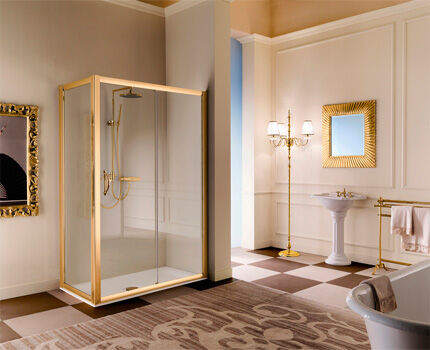
It is clear that the possibility of installing a cabin in one place or another is directly related to the size and shape of the shower tray - one of the main elements of the entire structure.
Sizes and shapes of water collectors
The overall dimensions of water collectors and its subsequent discharge into the sewer system, as a rule, are the basic parameters that determine the total usable area of a fully assembled shower stall. Structures for collecting and draining water can be divided into small, medium, and large, depending on their overall dimensions.
Compact products are limited to a size of 700 x 700 mm, the dimensions of medium-sized modules are within 800 x 800 mm, large collections have a width of at least 1100 mm.
The size that determines the depth of the shower tray is also significant. Insufficient or excessive depth of the pallet can complicate the assembly of the structure in some cases or, on the contrary, make the work of the installer easier.
The functionality of the hydromassage box and the degree of convenience for the user depend to some extent on the depth of the container.
In relation to this parameter, there is also a certain division in the design of shower trays:
- small (up to 40 mm),
- medium (up to 100 mm),
- deep (from 180 mm).
The configuration of the products according to their shape also provides the user with a wide choice. The most common are shower trays that have rectangular, square, and corner shapes.
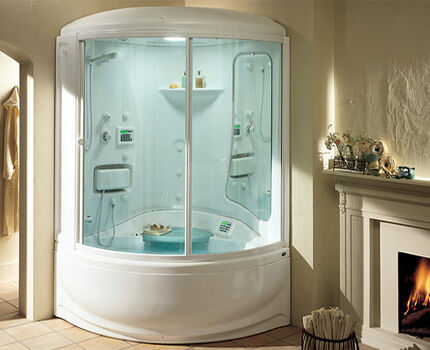
Simple shape configurations are usually preferred when there is a need to assemble a structure in standard bathroom conditions (city apartments, small cottages, condominiums).
In addition to traditional options for the shape of shower trays, there are also others:
- oval;
- round;
- cocked hats;
- pentagonal;
- exclusive.
If you choose by price, products of square, rectangular, and corner shapes are relatively inexpensive.
The assembly of the cabin with shower installation is not affected in any way by the configuration of the surface of the bottom of the tray. But this point is fundamental in terms of safety when using the shower.
The hydromassage box trays, which have a corrugated bottom surface, reduce the sliding effect to a significant extent. This ensures a higher level of security for the user.
Materials for pallets of household cabins
Shower trays are manufactured taking into account the possibilities for different installations.This approach pleases the consumer, but at the same time makes you think about assembling a tray for a specific shower stall.
However, thoughtfulness quickly goes away if the successful owner of the device is ready to carefully read the installation instructions, including the assembly of such an element as shower tray.
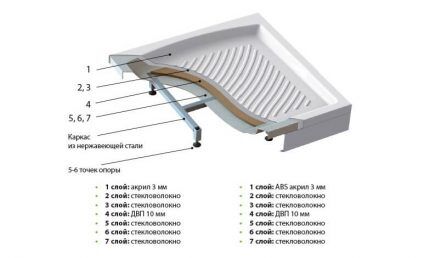
Manufacturers of hydromassage boxes make trays for collecting and draining water from different materials. The most common products are made from plastic or acrylic. For buyers, this is the cheapest option available, but in terms of performance characteristics it is not the most optimal.
The following materials are also used for the production of shower trays:
- enameled steel;
- processed cast iron;
- faience (ceramics);
- marble (artificial stone);
- quaril (a combination of quartz and acrylic);
- glass;
- and even a tree.
Earthenware and marble trays are best suited for shower enclosures, but assembling units with such trays requires an investment of a lot of money. The high cost here is due to the production technology of earthenware (marble) products.
These materials look beautiful, can heat up quickly and retain heat for a long time. In addition, faience and marble have increased wear resistance.
The disadvantage of earthenware and marble products is the fragility of these materials. Under shock loads, such structures can collapse.
Pallets made of quaril are on the list of expensive products after marble and earthenware. Quaril is a modern material, consisting of a mixture of acrylic and quartz.In terms of performance characteristics, quaril trays are only slightly inferior to ceramic ones.
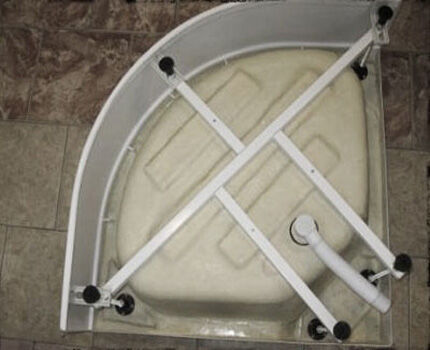
When a buyer becomes interested in shower cabins with a reinforced tray, the quaril option is usually considered first. Quaril pallets received the properties of strength and good thermal insulation due to the inclusion of quartz in the structure of the material.
Cast iron pallets have a low thermal conductivity coefficient, which means effective heat retention. However, it takes some time for cast iron to warm up.
Structurally, cast iron trays are a reinforced version of the base of shower cabins. They are strong and reliable, but without appropriate protection from the influence of the external environment there is a risk of corrosion.
Therefore, modern designs of cast iron trays intended for assembling a shower cabin are usually coated with protective enamel. A significant disadvantage of such products is their significant weight, which affects the assembly process.
Steel pallet models are also relatively strong structures. But steel pallets do not have pronounced heat accumulation properties. The operation of such structures under increased load is also not entirely clear.
There are examples of the operation of shower cabins when reinforced steel trays were deformed from overload. This type of product, just like cast iron pallets, is treated with enamel, and deformation leads to damage to the enamel coating. The degree of reinforcement of a steel structure is shown by the thickness of the material - the metal sheet.
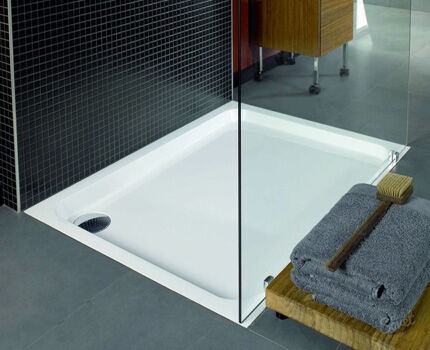
Acrylic containers for collecting and draining water are the most popular option used in shower cabin assemblies. Lightness, strength, good heat accumulation properties, and low cost have given acrylic projects the image of sought-after products.
For acrylic structures there are no restrictions on shapes and colors. They are easier to assemble than shower trays made from other materials. They are also easy and simple to repair if necessary. To strengthen acrylic shower trays, an additional metal frame is often installed.
The construction of the steel frame is carried out to smooth out the load in the central area of the bottom. It is in this area that cracks or fractures usually form.

Also, supports can be made of other materials: textolite, plastic, wood, etc. There are no strict schemes for manufacturing the reinforcement frame, although some shower cabins are equipped with ready-made solutions. Any scheme can be used. The main thing is to correctly determine the load zones and successfully select support points.
Brief photo instructions
So that you can visualize the scope and sequence of work on installing and connecting a shower tray, we suggest that you familiarize yourself with a photo selection. It demonstrates the main steps of the process:
The listed steps are essentially preparation for installation and connection of the shower tray. Upon completion, we proceed to the actual installation:
Installation of reinforced water collectors
Regardless of the configuration of the container for collecting and draining water included in the hydromassage box, the assembly of such a structure involves preparing the base for installation.
Preparation includes work aimed at leveling the surface of the floor and walls in the installation area. In addition, all necessary steps are taken to create effective waterproofing. A sewer line is marked and installed to drain water. We also recommend reading about how to properly connect the shower cabin to communications.
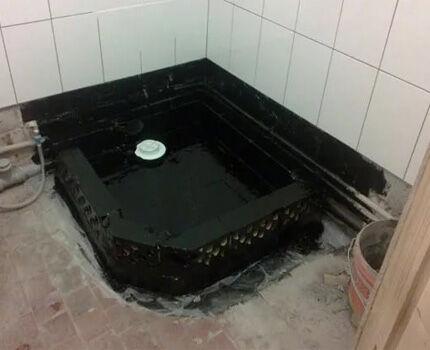
The drain line is connected to a point previously prepared and installed at the installation site, or to an existing bathroom drain system through a corrugated extension and tee.
In the latter case, it is necessary to maintain the difference in line level differences so that water can be drained without hindrance.The required drop value is achieved when assembling the shower tray by installing it to the required height.
To construct a drain into the sewer, you will need the following tools and materials:
- corrugated pipe (d=40 -50 mm);
- sanitary siphon;
- fluoroplastic sealing tape (FUM);
- building level;
- set of locksmith tools.
The plumbing siphon and part of the corrugated pipe are mounted on the body of the pallet before its installation in the prepared place. It is necessary to ensure the accuracy of installation of the siphon in full accordance with the attached instructions.
The position of the gaskets and the tightening of the fastening rings must ensure reliable tightness. It is recommended to check the insulation of the connections, close the outgoing end of the corrugation and fill siphon for shower cabin a small amount of water. If no leak is found, you can safely assemble the system.
Pallet assembly instructions
Let's look at several popular options for installing a shower tray or shower enclosures. Each of them has its own characteristics, although the order of actions is usually the same.
Option #1 - acrylic structure with reinforcement
A reinforced version of the shower tray involves the use of a strength frame. The frame frame is usually strengthened at the bottom of the pallet using special metal pins. Such pins are screwed at one end into holes located along the edges of the pallet, and support “legs” are screwed onto the other end of the pins.
Frame metal elements are placed just above the support legs, under the bottom of the pallet. Their position vertically and horizontally can be adjusted with nuts and fixed with locknuts.
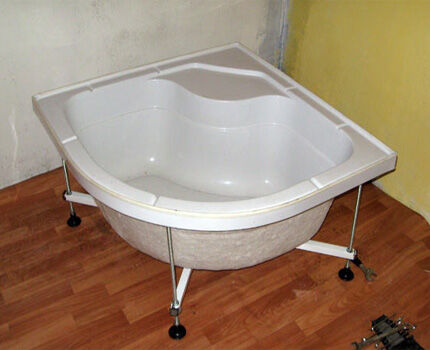
Equipped with reinforcement elements and support legs, the shower tray is placed at the location. By rotating the support legs in one direction or another, the pallet is leveled horizontally. The accuracy of the horizon is controlled by the building level.
It is also necessary to maintain the specified size of the installation height of the pallet in order to ensure the conditions for the difference in the drain level. According to the requirements, this difference must be at least 20 mm per 1 meter of sewer line length. Then all that remains is to hang the decorative panels.
A similar assembly technology traditionally applies to shower cabins, where an acrylic water collector is used in the kit. Some steel pallet projects may also involve similar installation, but not always.
Option #2 - installation of a steel pallet
Household models of shower cabins with a steel tray are usually produced in two types: shallow in depth (less than 300 mm) with overall dimensions of 800 x 800 mm or 900 x 900 mm and deep (more than 440 mm) with dimensions of only 800 x 800 mm.
But the requirements for connecting to the sewerage network are the same. Thus, from the point of view of sewerage connections, there is no global difference in the installation of steel pallets.
Another thing is assembling a shallow and deep steel pan, with an eye to the supporting component. Deep structures with a high side are usually equipped with supporting parts - legs (included in the delivery set).
Option #3 - assembly on a homemade foundation
But the assembly of shallow shower trays is usually carried out on a foundation or on supports made by hand, since in this case the complete set of supports is not provided.
The foundation for a steel shower tray can be brick, stone, block, etc. In the case of supports, you can use metal parts (channels, pipes, corners).
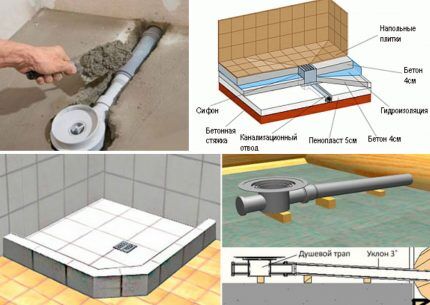
Assembly on masonry involves precise definition of the contour of the steel pallet. Along this contour, with a slight indentation inward (5-10 mm), the foundation is laid.
As the masonry is completed, one should take into account the creation of a slight slope towards the sewer inlet. Thin-walled steel collectors are not particularly durable.
Therefore, in this assembly option, the structure should be strengthened with an additional frame or brick support columns should be laid directly under the points with maximum load. This approach will protect the steel pallet from deformation.
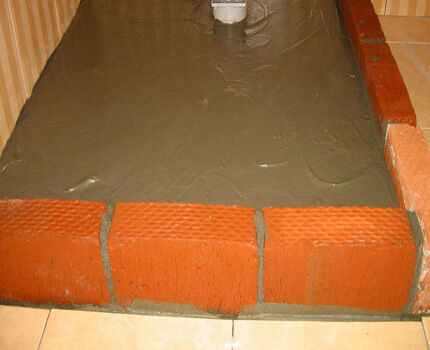
A high-quality damping material, for example, a tape made of hard technical rubber half the width of a brick, should be laid on the surface of the brick foundation. All additional supporting elements of the foundation are equipped with the same dampers.
Next, the steel water collector is placed on the foundation, the siphon is assembled with a drain line, after which the entire structure is finally fixed. Typically, a steel water tank is fixed to the foundation using cement mortar. If you are interested in a homemade tile tray, we recommend reading the detailed instructions for its construction, which are available on our website.
Conclusions and useful video on the topic
Useful information from the video will help you install plumbing equipment yourself.
Assembling the acrylic tray:
Intentions to change the furnishings of the bathroom in an apartment in a municipal residential building are not the exclusive prerogative of the apartment owner. Owners of municipal housing should remember the existing rules related to the reconstruction of premises and communications. Only after receiving the appropriate permission from the authorities can construction or installation work begin.
Do you have any questions, notice any inaccuracies, or want to add valuable information to this material? Leave your comments in the block below. Or maybe you had to assemble a shower tray yourself - share your experience with our readers.




I assembled the pallet myself, I can say that the work is not technically difficult, but very painstaking. You need to carefully prepare the space for the shower, measure everything, and quite a lot of drilling is required. The gluing must also be precise so that there is not the slightest gap left. In the end, I installed the shower after fussing all day and cursing everything in the world. It would be better to hire a plumber.